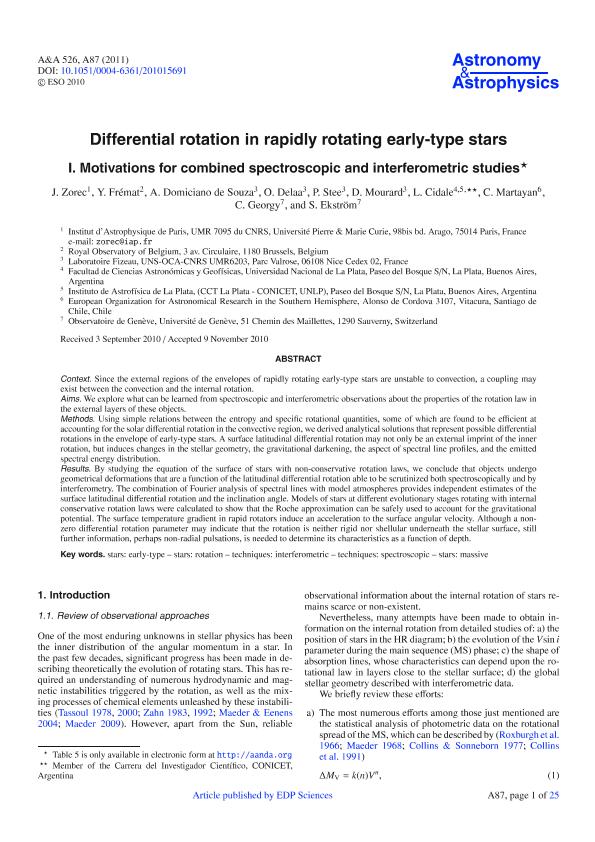Artículo
Differential rotation in rapidly rotating early-type stars. I: motivations for combined spectroscopic and interferometric studies.
Zorec , J.; Frémat , Y.; Dominiciano de Souza, A.; Delaa, O.; Stee, P.; Mourard, D.; Cidale, Lydia Sonia ; Martayan, C.; Georgy, C.; Ekstrom, S.
; Martayan, C.; Georgy, C.; Ekstrom, S.
 ; Martayan, C.; Georgy, C.; Ekstrom, S.
; Martayan, C.; Georgy, C.; Ekstrom, S.
Fecha de publicación:
02/2011
Editorial:
Edp Sciences
Revista:
Astronomy And Astrophysics
ISSN:
0004-6361
Idioma:
Inglés
Tipo de recurso:
Artículo publicado
Clasificación temática:
Resumen
Context. Since the external regions of the envelopes of rapidly rotating early-type stars are unstable to convection, a coupling may
exist between the convection and the internal rotation.
Aims. We explore what can be learned from spectroscopic and interferometric observations about the properties of the rotation law in
the external layers of these objects.
Methods. Using simple relations between the entropy and specific rotational quantities, some of which are found to be efficient at
accounting for the solar differential rotation in the convective region, we derived analytical solutions that represent possible differential
rotations in the envelope of early-type stars. A surface latitudinal differential rotation may not only be an external imprint of the inner
rotation, but induces changes in the stellar geometry, the gravitational darkening, the aspect of spectral line profiles, and the emitted
spectral energy distribution.
Results. By studying the equation of the surface of stars with non-conservative rotation laws, we conclude that objects undergo
geometrical deformations that are a function of the latitudinal differential rotation able to be scrutinized both spectroscopically and by
interferometry. The combination of Fourier analysis of spectral lines with model atmospheres provides independent estimates of the
surface latitudinal differential rotation and the inclination angle. Models of stars at different evolutionary stages rotating with internal
conservative rotation laws were calculated to show that the Roche approximation can be safely used to account for the gravitational
potential. The surface temperature gradient in rapid rotators induce an acceleration to the surface angular velocity. Although a nonzero
differential rotation parameter may indicate that the rotation is neither rigid nor shellular underneath the stellar surface, still
further information, perhaps non-radial pulsations, is needed to determine its characteristics as a function of depth.
Archivos asociados
Licencia
Identificadores
Colecciones
Articulos(IALP)
Articulos de INST.DE ASTROFISICA LA PLATA
Articulos de INST.DE ASTROFISICA LA PLATA
Citación
Zorec , J.; Frémat , Y.; Dominiciano de Souza, A.; Delaa, O.; Stee, P.; et al.; Differential rotation in rapidly rotating early-type stars. I: motivations for combined spectroscopic and interferometric studies.; Edp Sciences; Astronomy And Astrophysics; 526; a87; 2-2011; 1-25
Compartir
Altmétricas



